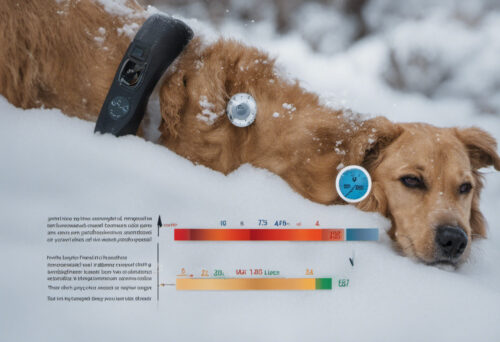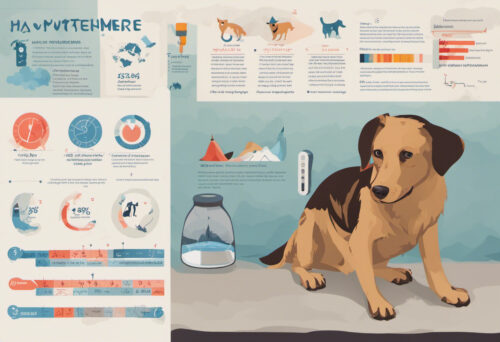Are you a proud pup parent always on your toes when it comes to your dog’s health? If so, it’s crucial to not only know about common threats like ticks and fleas but also about more serious issues such as hypothermia. Yes, you read that right! Canine hypothermia is not just a winter worry but can affect dogs at any time of the year due to various reasons. Let’s dive right into understanding this worrisome ailment, its signs, and what to do if you suspect your four-legged friend might be suffering from it.
Understanding Canine Hypothermia
Hypothermia in dogs, similar to hypothermia in humans, is a dangerous drop in body temperature. It can happen due to exposure to cold temperatures, especially when combined with wetness. However, other factors such as low blood sugar and hypothyroidism can also be potential causes. Confused about what exactly hypothyroidism in dogs is? Don’t worry! It’s a condition that affects your dog’s thyroid gland and can easily be managed with your vet’s help.
Identifying Symptoms of Canine Hypothermia
As a responsible dog owner, it’s your job to be able to identify the potential signs of hypothermia. So, what should you look out for?
Low body temperature
Most dogs’ normal body temperature ranges from 101 to 102.5 degrees Fahrenheit. If your pet’s temperature drops below 99 degrees, it’s time to call your vet as it can be a sign of hypothermia.
Shivering
Shivering is the body’s natural response to cold and an initial sign of hypothermia. But always remember, uncontrollable shivering is a critical indicator that your pooch is likely suffering from the beginning stages of hypothermia. This article by the American Kennel Club explains it all.
Weakness and lethargy
Is your dog showing signs of weakness or lethargy? These symptoms are not to be taken lightly. If your pup has hypothermia, it may show visible signs of exhaustion and move more slowly than usual.
How to Treat Canine Hypothermia
While it’s crucial to take your dog to the vet if you suspect hypothermia, there are immediate measures you can take to begin raising your furry friend’s body temperature.
Wrap them up
One of the first things you should do is wrap your dog in warm blankets. If you don’t have any blankets on hand, use your own body heat to help your pooch stay warm. The aim here is to gradually increase their body temperature and prevent it from falling any further.
Heat packs or hot water bottles
Applying gentle heat using hot water bottles or heat packs can be very effective, but always remember to wrap them in a cloth to prevent burns.

Seek Veterinary Attention Immediately
Recognising the signs of hypothermia in your dog and starting initial treatment at home are crucial steps. However, you should contact your vet immediately upon observing any of these signs. It’s always better to err on the side of caution.
Dehydration
Canine hypothermia can often lead to dehydration, so it’s important to ensure your dog stays hydrated. Some dogs will drink on their own, but others might need encouragement. Try offering them room temperature or slightly warm water to encourage drinking and to help warm them up.
Nutrition
High-calorie, high-protein foods are good for hypothermic dogs as they help boost energy and aid recovery. Discuss with your vet about an appropriate diet and changes in feeding habits.
Preventing Canine Hypothermia
As the popular saying goes, “prevention is better than cure”, and it holds true for canine hypothermia as well. Let’s look at some ways to prevent this condition in your pet.
Proper Shelter
To help your pooch fight the cold, make sure they have a warm and cosy shelter. This might mean a heated bed indoors, a good quality dog house filled with warm bedding if outside, or simply keeping them inside your house during cold months.
Clothing
Just as with humans, clothing can help dogs maintain their body heat. Consider getting your friend a doggy sweater, coat, or raincoat, depending on the weather.
Regular Vet Check-ups
Regular vet check-ups are crucial to prevent hypothermia, especially in dogs with underlying conditions that predispose them to it. If a condition such as hypothyroidism is managed effectively, it can reduce the likelihood of your dog experiencing hypothermia.
Exercise Moderation
Exercising your dog is part of basic canine healthcare, but be cautious in cold weather. Exercise might be necessary, but excessive exercise might lower the body temperature and increase the chances of hypothermia.
Remember, no amount of love or care can substitute for prompt medical attention during emergency situations. Being alert to changes and acting promptly is key to being a responsible and informed owner.

Beware of the Chill: Common Canine Hypothermia Contributors
Did you know that various activities can accelerate the onset of canine hypothermia? A damp environment, snow baths, or a mere romp in cold waters during the frigid months can all cause your furry friend’s body temperature to plummet. So, ensure your pal is always dry and warm during cold spells.
How about Older Dogs and Puppies?
Just like human beings, puppies and older dogs are more susceptible to hypothermia. Understand the unique health challenges of your aging pet and ensure you provide extra warmth for puppies when it’s needed most!
Does Breed Matter?
Yes! Certain breeds, like short-haired breeds and small dogs, such as Chihuahuas, are more susceptible to the cold. On the contrary, breeds like Huskies and Saint Bernards fare better in colder climates. Knowing your dog’s breed characteristics can help you better protect them from hypothermia.
Leading The Charge: You are the First Responder!
Being the first line of defense in recognizing and addressing canine hypothermia puts pressure on owners, but that’s where we, as devoted parents, shine brightest. Let’s recap the key points!
Review Regularly
Doing regular health-check and keeping track of your dog’s normal behaviour will quickly alert you to any changes, be it altered gait, lowered energy levels or drop in appetite. A complete care plan as suggested by this WebMD article will prepare you for successfully handling health emergencies like hypothermia.
Have a Plan
Plan for emergency situations, including having important phone numbers on hand, knowing the fastest route to your vet or 24-hour emergency animal hospital, and keeping a well-stocked pet first aid kit.
Trust your Gut
If you suspect something might be wrong with your dog, it probably is. Recognizing early signs of hypothermia and acting quickly can save your furry friend’s life. Trust your instincts and when in doubt, seek help.
Wrap Up: Preventing Hypothermia is a Lifesaver!
While hypothermia can be a serious health concern for dogs, the good news is that with knowledge and preparation, it’s entirely preventable. As an at-attention pet parent, understanding the causes of hypothermia, noticing symptoms, responding correctly, and having a prevention plan will make you a walking, talking lifesaver!
And always remember: you’re not alone on this journey of keeping your canine companion safe and healthy. There are numerous resources available at your fingertips to guide you along the way. Let’s make every effort count for our fur babies’ well-being!



